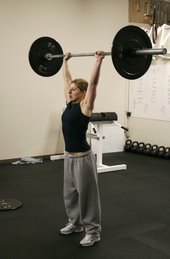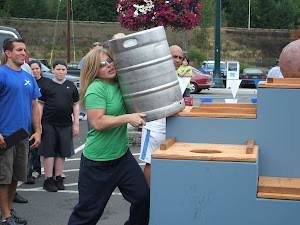If I didn't constantly wear white Hanes premium tank tops purchased on sale and in bulk at Target, I might be re-engineering my spring wardrobe and packing away winter clothes right about now. In my defense, nothing cripples your fashion sense faster than wearing a uniform every day for eight years straight. Nobody does that other than comic strip characters without suffering a stunting fashion PTSD. I'm in a support group now with Peppermint Patty but then I digress - perhaps habitually.
Even if my tank tops are perennial, there are dietary and fitness habits that are not. Every season I need to reconsider scheduling, food availability and how I'd prefer to spend my time. In the spring, I notice that I get antsy in the gym and I plan ways to duck out early. I also notice that standing at the stove while the sun shines feels like a task assigned by an evil stepsister without even the faint hope of rescue and cool shoes (which leads to me to the question: if you dance and consequently sweat in glass slippers, do they fog over and if so, um, ick! but again, I digress)
Local and Lavish
Last year, I tried to do an 'Eat Local/Eat Seasonal' thing until the fall when I think I suffered some sort of Yam/squash toxicity and nearly went mad. Roasted root vegetables - shudder. Even now I hurry past the isle in Whole Foods and try not to look a yam in the eyes. It's a noble cause and worth trying when it's not nearly as painful and there's a little bit of choice. It's beneficial because you'll be eating food at its nutritional peak, it will be cheaper, you'll cut down on the cost and waste of fossil fuels by avoiding vegetables that clearly vacation more extravagantly than you, and you'll support local farmers who are wise enough to grow something other than corn and soy even when it's not subsidized.
A couple in Vancouver wrote the '100 mile diet' about this very topic and you can join the movement. Why, you ask? Because it gives some direction and purpose to your nutrition at a point BEFORE you start zone blocking Frozen Mudslides and calling it good. You can always fake an injury at the end of the summer and quit before you get bum rushed by beets.
Salad Solutions
Summer salads look phenomenal because they're nutrient dense, full of variety, and a perfect excuse to slop everything into one bowl like pet food and pretend it's not because you're lazy. And there's good reason to eat raw food other than lack of time or focus. Like the '100 Mile Diet' there's a whole movement (ok, that's kind of a potty humor pun, my apologies) associated with raw foods and their health benefits. The article "Enzymes: The Difference Between Raw and Cooked Foods," by Emily Kane ND explains:
Although the enzyme-producing organs continue to function over the entire course of a healthy life, they eventually wear down, especially with the "standard American diet" (which, in the naturopathic community, we call SAD.) Dr. Francis M. Pottenger's nutritional studies have shown that a regular diet of cooked or canned foods causes the development of chronic degenerative diseases and premature mortality. Professor Jackson of the Dept. of Anatomy, University of Minnesota, has shown that rats fed for 135 days on an 80 percent cooked food diet resulted in an increase pancreatic weight of 20 to 30 percent. What this means is that the pancreas is forced to work harder with a cooked food diet. "Although the body can manufacture enzymes, the more you use your enzyme potential, the faster it is going to run out..." wrote Dr. Edward Howell, who pioneered research in the benefits of food enzymes. A youth of 18 may produce amylase levels 30 times greater than those of an 85 year old person.
Enzymes are what make seeds sprout. Sprouts are, in fact, one of the richest sources of enzymes. Other excellent sources are papaya, pineapple and the aspergillus plant. Science cannot duplicate enzymes, because they are the stuff of life itself. Only raw food has functional "live" enzymes. Therefore the liver, pancreas, stomach and intestines must come to the rescue and furnish the requisite digestive enzymes to the individual nourished solely on a cooked food diet. This extra activity can be detrimental to health and longevity because it continually taxes the reserve energy of our organs. Furthermore, cooked food passes through the digestive tract more slowly than raw food, tends to ferment, and throws poisons back into the body. Colon cancer is second only to lung cancer as a killer in America and is related, in various ways, to eating enzyme-deficient cooked food.
Prolonged intestinal toxemia may manifest the following symptoms: Fatigue, nervousness, gasto-intestinal discomfort, recurrent infections, skin eruptions, hormonal disturbances, headaches, arthritis, sciatica, low back pain, allergies, asthma, eye, ear, nose and throat disorders, cardiac irregularities, pathological changes in the breasts, and so forth. All of these conditions have been shown to respond to therapy directed to correcting the bowel toxemia. Of course, it is important to have fiber in the diet to scrub the colon walls clean, but even more important are the enzymes which will allow proper digestion and assimilation of vital nutrients. Cooked food often passes into the bloodstream as unsplit molecules that are deposited, as waste, in various parts of the body. If it is a fat molecule we know it as cholesterol plaque; if calcium, arthritis; if sugar, diabetes. White blood cell count rises dramatically after ingesting a meal of canned or cooked foods ("digestive leukocytosis"). Elevated WBCs are correlated to bacterial infection, inflammation and depressed immunity. Raw foods do not produce this reaction. All raw foods contain exactly the right enzymes required to split every last molecule into the basic building blocks of metabolism: Amino acids (from protein), glucose (from complex carbohydrates) and essential fatty acids (from unsaturated vegetable fats).
Go Outside, duh!
Don't skip your workout entirely, just make room for it outside. It seems like an obvious answer but you'd be surprised how many people take an either/or approach to this issue. Just because you don't like biking or running doesn't mean you can't find a worthwhile activity that will keep you active.
I have a kettlebell that spends most of it's winter behind my driver's seat potentially killing my gas mileage and doing funky things to my tire alignment and wear patterns. In the summer, I bring it to Greenlake. It would be worth doing even if there wasn't a secret joy in swinging it all Hagar the Horrible style to the alarm of soccer mom's with strollers and yippy dogs who swallow the impending yap when they realize I might level them. It would be better if I could glare all crazy-like.
Whatever you decide to do, create some intentionality around it. The biggest issue with a change in seasons is the lack of a plan which switches you into coast mode. As a result, everything unravels and you forget why (though arguably, that could have something to do with the poorly zone-blocked Mud Slides . . . .)
skip to main |
skip to sidebar








A conversation with my clients about exercises, work-outs and nutrition
Search This Blog

About Me
- Heather
- I'm an NSCA-PT and CrossFit certified personal trainer with nine years experience. I hold a purple belt in Brazilian Jiu Jitsu under Marcelo Alonso and Ben Blackstone and I am a Karnataka State Gold Medalist in Weightlifting.

Books
Brain Rules: 12 Principles for Surviving and Thriving at Work, Home, and School Food Politics: How the Food Industry Influences Nutrition, and Health, Revised and Expanded Edition (California Studies in Food and Culture)
Food Politics: How the Food Industry Influences Nutrition, and Health, Revised and Expanded Edition (California Studies in Food and Culture) Good Calories, Bad Calories: Fats, Carbs, and the Controversial Science of Diet and Health (Vintage)
Good Calories, Bad Calories: Fats, Carbs, and the Controversial Science of Diet and Health (Vintage) The Omnivore's Dilemma: A Natural History of Four Meals
The Omnivore's Dilemma: A Natural History of Four Meals Practical Programming for Strength Training
Practical Programming for Strength Training PROTEIN POWER
PROTEIN POWER Secrets of the Soil : New Solutions for Restoring Our Planet
Secrets of the Soil : New Solutions for Restoring Our Planet Starting Strength (2nd edition)
Starting Strength (2nd edition) The Brain Trust Program: A Scientifically Based Three-Part Plan to Improve Memory, Elevate Mood, Enhance Attention, Alleviate Migraine and Menopausal Symptoms, and Boost Mental Energy
The Brain Trust Program: A Scientifically Based Three-Part Plan to Improve Memory, Elevate Mood, Enhance Attention, Alleviate Migraine and Menopausal Symptoms, and Boost Mental Energy Fiber Menace: The Truth About the Leading Role of Fiber in Diet Failure, Constipation, Hemorrhoids, Irritable Bowel Syndrome, Ulcerative Colitis, Crohn's Disease, and Colon Cancer
Fiber Menace: The Truth About the Leading Role of Fiber in Diet Failure, Constipation, Hemorrhoids, Irritable Bowel Syndrome, Ulcerative Colitis, Crohn's Disease, and Colon Cancer The Revolution Will Not Be Microwaved: Inside America's Underground Food Movements
The Revolution Will Not Be Microwaved: Inside America's Underground Food Movements The Zone: A Dietary Road Map to Lose Weight Permanently : Reset Your Genetic Code : Prevent Disease : Achieve Maximum Physical Performance
The Zone: A Dietary Road Map to Lose Weight Permanently : Reset Your Genetic Code : Prevent Disease : Achieve Maximum Physical Performance Twinkie, Deconstructed: My Journey to Discover How the Ingredients Found in Processed Foods Are Grown, Mined (Yes, Mined), and Manipulated into What America Eats
Twinkie, Deconstructed: My Journey to Discover How the Ingredients Found in Processed Foods Are Grown, Mined (Yes, Mined), and Manipulated into What America Eats Mind the Gap: The Science Behind the Sporting Mind
Mind the Gap: The Science Behind the Sporting Mind Extraordinary Knowing: Science, Skepticism, and the Inexplicable Powers of the Human Mind
Extraordinary Knowing: Science, Skepticism, and the Inexplicable Powers of the Human Mind The Subtle Body: An Encyclopedia of Your Energetic Anatomy
The Subtle Body: An Encyclopedia of Your Energetic Anatomy Stumbling on Happiness
Stumbling on Happiness
Products


Resources
- Art DeVany
- Brain Health
- Buy Kettlebells
- CrossFit Eastside
- CrossFit Main Page
- Dr. Cordain's Research
- Dr. Eades
- Dr. Ladd Carlston
- Dr. Randip Singh
- Environmental Working Group
- Food, Farming & Healing Arts
- Get Up! Newsletter
- Health Geek's Wikipedia
- Homework for 10a Class
- Jennifer Adler M.S., C.N.
- Marcelo Alonso BJJ
- Michael Pollan
- O'Lifting Coach Mike Burgener
- Predictably Irrational
- Robb Wolf
- TED: Ideas Worth Spreading
- THIS IS THE PREFERRED MEAL TRACKER
- Tim Ferriss, 4 Hour Work Week


